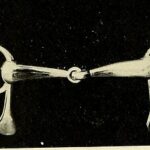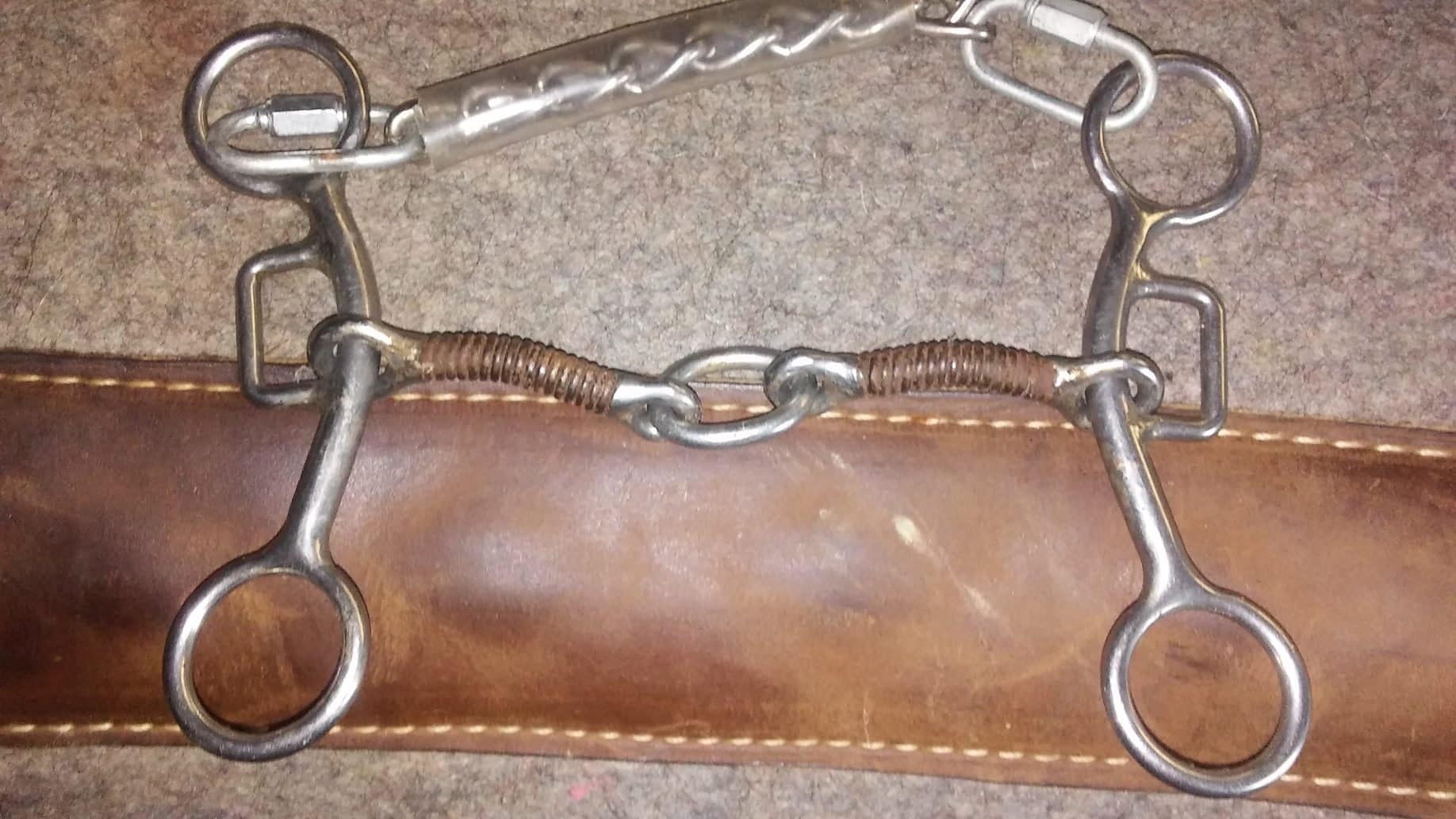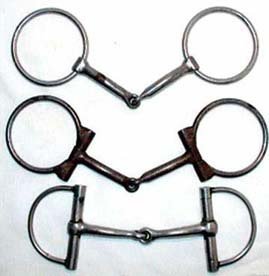

Bitless bridles are one of the most controversial points of the horse industry. They can be anything from the traditional vaquero bosal to the increasingly common mechanical hackamore. Bitless is often touted as “more humane” than bits, with devote followers shaming bits as abusive and “old-fashioned.”
The Vaquero Bosals

Bosals were used to start the famous vaquero horses in the first few years of their training. The bosal allowed the colts to be trained while preserving their sensitive mouths during the time when their teeth were growing and changing. Gradually, bits would be introduced and, eventually, the best horse would be trained in the art of the spade. But traditional bosals were never meant as a long-term replacement for bits. They were simply a stepping stone in the early training process. They are not as popular in the bitless community because they don’t work as well for plow-reining.
Sidepulls
Basic sidepulls have been around for quite a while. They are the bitless version of a snaffle. It doesn’t work off of a million pressure points or aspire to be a boa constrictor around your horse’s face, so if you are determined to go bitless, I’d say this is a pretty safe option. I’ve never heard of horses getting nerve damage or other facial damage from one, anyway. That being said, you better have a horse that is very soft and supple with a great one rein stop and a snappy yield the hindquarters, otherwise, if your horse decides to run through the bridle you’re shit out of luck.
Over-Simplistic Solutions
Here’s the rub with both bosals and sidepulls as long-term bitting choices: they are both overly simplistic. They’re both great choices for the beginning stages of training. But most horses will soon figure out that they don’t have much bite, so running through the bridle is really easy with either of these options no matter how well trained you horse is. I’m not saying that there aren’t horses that can’t go their whole lives in one of these — if that’s you, then more power to you — but most horses are going to at least need regular tune-ups in something a little stronger (like a snaffle) to remind them to respect the rider’s hands.
If you want to take your training further than just the basics, you will find yourself needing to transition to some sort of bit in order to get the finesse you desire.
[click_to_tweet tweet=”Sidepulls are an over simplistic solution. Most horses will soon figure out that they don’t have much bite, so running through the bridle is really easy. #horses #247equestrian Read more:” quote=”Sidepulls are an over simplistic solution. Most horses will soon figure out that they don’t have much bite, so running through the bridle is really easy.”]
Dr. Cook’s Bitless Revolution
The current fad of bitless bridles was started by Dr. Cook’s invention of a new kind of sidepull hybrid that works off of poll pressure. This is ok for horses who don’t mind poll pressure and it’s certainly better than a lot of mechanical hackamore atrocities you see people running around with. But it’s not the most effective tool I’ve ever seen either. I’ve never met a horse that actually liked one. Every horse I’ve seen ridden in one tolerated it and their riders raved about it, but they invariably failed to notice how dull and unresponsive it made their horses. If you’re set on going bitless, their are worse choices you could make, but there is a reason why successful show horses use bits and when I’m out on a trail, I want my horse to be every bit as responsive. Out in the mountains, responsiveness can mean the difference between life and death and I’m quite fond of the idea of both my horse and I living to ride another day.
Faulty Research
Looking at Dr. Cook’s own research as published in the archives of his website, the research on which the whole theory behind his bitless bridle is based on a shaky foundation. The primary subjects discussed in the research were racehorses. The primary problems found with bits in racehorses boiled down to evasion of the bit and heaviness on the forehand.
Now, I do not claim to be an expert on racehorses, but I know a thing or two about training non-race horses. Bit evasion and heaviness on the forehand are never ok. If you are galloping around on the forehand hauling on the horse’s mouth and said horse is evading the bit so much he’s swallowing his own tongue and suffocating himself, you’ve got bigger problems then what bit you’re using. No horseman or horsewoman worth a damn would ride like that off the track. If you do, shame on you. If you don’t, Dr. Cook’s special bridle is a moot point and a fad fashion accessory rather than a must have item to ensure the well being of your horse.
[click_to_tweet tweet=”If you don’t ride your horse around on the forehand hauling on his mouth like a racehorse jockey, Dr. Cook’s special bridle is a moot point and a fad fashion accessory. #horses #247equestrian Read more:” quote=”If you don’t ride your horse around on the forehand hauling on his mouth like a racehorse jockey, Dr. Cook’s special bridle is a moot point and a fad fashion accessory.”]
Ok, I know there’s someone out there who’s screaming at their computer screen: “But my Fluffy needs his Dr. Cook bridle! How dare you say he doesn’t!”
Maybe Fluffy has bad teeth or some rare medical problem that your vet genuinely recommended a bitless bridle. Ok, sure. So Fluffy needs a bitless bridle for medical reasons. There are a few horses that do. But, for most people, the super duper special Dr. Cook bridle is nothing more than a market gimmick and a brilliant one at that (I tip my hat to you sir) but a gimmick none the less.
Mechanical Hackamores

Here’s the bitless bridle that I see the most and it’s the one that is certainly the most dangerous. The term hackamore started as another name for the vaquero bosal. Remember what we discussed a few paragraphs ago about the over-simplistic limitations of the bosal? The “mechanical hackamore” is a modern attempt to overcome those shortcomings.
It’s the same principle as slapping a bigger bit on a horse that won’t respond to a snaffle. In this case, someone thought it would be a great idea to add leverage to a hackamore. Now, if you remember our discussion of leverage ratios in the Leverage Bit Basics article, you will know that the length of the shank compared to the length of the purchase is what determines the leverage ratio. Many “mechanical hackamores” such as the one pictured have a leverage ratio of at least 3:1. That means that for every 1 pound of pressure you apply to the reins, the horse feels 3 pounds of pressure. Too many people think that because their “hackamore” doesn’t have a bit through the mouth it’s automatically “humane.” Somehow this seems to give them leave to yank on the poor horse’s face because it’s a “hackamore” so it’s humane no matter how you abuse it.
The Anatomy of a Horse’s Head

This is something that not enough people understand. Take a look at this horse skull. Do you see that pointy protrusion at the nose? That is a delicate piece of bone that is so thin you can actually see light through it if you hold a flashlight on the other side. This is the part of the nose where most bitless bridles, including mechanical hackamores, sit. Look at how thin and delicate that is. Now go pinch the cartilage of your own nose for a few seconds. Do that a couple times in a row, let it sit for a few minutes, then pinch it a couple more times.
How tender is your nose right now?
Do the math. How much you you think it would hurt if you applied 1 pound of pressure to that cartilage on your nose? Now, how much do you think it would hurt if you were using a mechanical hackamore with a 3:1 leverage ratio that made that 1 pound feel like 3 pounds of pressure?
How long was your last ride? 1/2 hour? 1 hour? How sensitive would you nose be if you kept applying just 1 pound of pressure to the cartilage on your nose for 1 hour? Ow! That hurts just thinking about it!
Now which do you think is more humane? A properly fitted snaffle bit or a bitless bridle?
[click_to_tweet tweet=”Try applying 1 pound of pressure to the cartilage of your nose and see how comfortable it is. Now how would it feel if you applied the 3:1 ration of some popular mechanical hackamores? #horses #247equestrian Read more:” quote=”Try applying 1 pound of pressure to the cartilage of your nose and see how comfortable it is. Now how would it feel if you applied the 3:1 ration of some popular mechanical hackamores?”]
Photo by eXtensionHorses










I’m super late to the party, but I had to add my two cents. The bosal (I will refer to it as hackamore from now on) is a lot more complex than one might think. The spade bit horse is made in the hackamore. Yes, some modern hackamore trainers will start in the snaffle, transition to the hackamore, then to the curb (whether it’s a spade or other type). But there are still those who do it the old way: hackamore, two rein (small bosal + curb bit), then straight up in the bridle. Mastering the hackamore is an art form and yes, a horse should easily be able to stay in it his whole life and remain light and responsive (as long as the rider stays light as well). As the author says, plow reining is not effective in the hackamore, and that is where the vast majority of people go wrong; that’s what creates a dull horse that needs to be sensitized with a bit. The hackamore works on a subtle shift of weight and requires the rider to have a good feel in their hands and body. I’m not against bits at all, but a (well made!!) hackamore is one of the most versatile tools out there, and I’d argue that in the hands of a master has more subtlety than a snaffle. You can probably tell I’m a bit of a nerd about this subject, I apologize for rambling on. If anybody is interested. Vaquero rider/trainer Jeff Sanders has written books on both the hackamore and the bridle and they are very interesting even if you don’t intend to pursue the Vaquero discipline.
Your frankness and writing style are great. I just bought a mechanical hackamore for a greenie who won’t take the bit (my fault). Now I find out that the rider should be very, very careful with it. I already ride and train off of seat and leg so I’m hoping I won’t have any issues. Having to ride with light responsive hands seems a plus to me as a rider. We’ll see how the mare likes it.
I’m four years late to this thread but alas. I recently tried my trainer’s mechanical hackamore with my new mare and it has been a game changer. Not the German Mechanical that you showed above, but still a mechanical one. We tried it out by a sort of accident – mare had a knick on the side of her lip (not bit related) and we decided to slap on the hackamore so the lip could heal. She’s pretty quick footed so we figured… if I die I die… and we never try it again haha. But she ended up loving it! She became so soft and just…happy, and my position became much better. It felt like things just fell into place.
I agree that bitless riding isn’t inherently “more humane” but the best way to know if your gear is “more humane” is to simply see how your horse reacts. My mare showed me that she truly enjoys our rides in the hackamore, so I’ve added it to our toolbox. Overall great and informative post! Just wanted to say that few pieces of gear are inherently good or bad, and if your horse becomes happier and your hands softer in a certain kind of gear – keep using that gear. That goes for both bits and hackamores. Thanks a lot for pointing out the horse skull/anatomy! I will definitely be paying extra attention on placement when I fit the new piece I ordered.
I will always go for my properly fitted bridles with the most comfortable bits rather than the many ill fitting bitless bridles that I’ve seen recently!
A properly fitted bit is usually a better choice unless you have a special circumstance where a horse needs to go bitless due to some sort of health issue. Bitless bridles are hard to fit and even harder to convince a horse to accept.
Thanks for stopping by!
I have heard those side-pulls are wonderful. They apply a good amount of pressure without being overbearing. Very informative, thank you!
They are definitely some of the best bitless options if you want to go that route. Glad you enjoyed it. Thanks for stopping by!
Very interesting post! I ride in a snaffle and have never really thought about goong bitless – not with my mare anyway – but it certainly puts into perspective those who believe they are being humane and how far their knowledge goes.
I’m glad you enjoyed it and found it educational. I think the bitless trend is biggest in the US. I’m sure other countries have it too, but we’re probably the worst for taking silly trends and blowing them out of proportion.
This is a very interesting read, thank you! I do have a short-shanked mechanical myself, but with extra ring so it can be used as a sidepull. But I rarely use it though. If I decide to go bitless, it’s either with nothing or a neckrope. I do have a practical leather bit as well, that my horse seems to like a lot. But for hacks we usually always ride in a bit, and that bit is the straight eggbutt. Very nice blog post!
Well you’re certainly braver than me! You won’t catch me riding in a neckrope, much less nothing. Glad to hear that you use a bit outside of the arena. Very smart. It scares me when I hear people trying to go tackless outside of the arena. Then again, I do have a shattered spine and nerve damage already (not from going tackless or bitless though), so that’s probably why I’m overly cautious about pulling stunts like that. Lol. Glad you liked it!
Thank you for taking the time to comment!